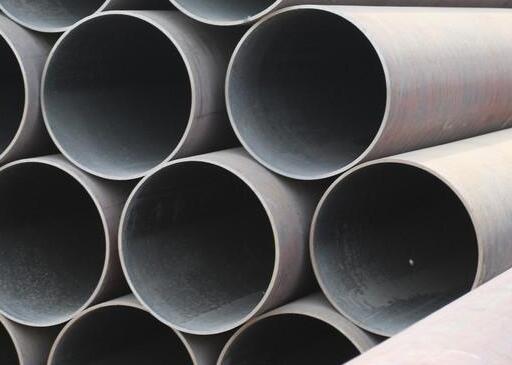Seamless steel pipe is a hollow, seamless pipe. Its manufacturing process eliminates welding or seam treatment, resulting in greater structural continuity and uniformity. Seamless steel pipe with an outer diameter greater than 108mm is generally referred to as large-diameter seamless steel pipe. It is commonly used in industrial applications requiring high pressure, high temperature, or to transport large volumes of fluid. Due to its unique manufacturing process and structural characteristics, this type of steel pipe plays an irreplaceable role in a variety of fields.

Production Process for Large Diameter
Seamless Steel Pipe
1. Hot Rolling
This is the primary method for producing
large-diameter seamless steel pipe.
The round billet is first heated to
1100-1250°C to achieve good plasticity. The solid
billet is then punched through a piercing mill to form a hollow shell.
The shell undergoes multiple rolling passes
(such as three-roll cross-rolling, continuous rolling, or extrusion) to
gradually reduce its outer diameter and wall thickness to the desired size. The
shell then undergoes subsequent processing steps such as sizing, cooling,
straightening, and flaw detection.
2. Cold Drawing/Cold Rolling Process
For large-diameter seamless steel pipes
requiring higher precision and thinner wall thickness, cold drawing or cold
rolling is performed in addition to hot rolling.
Cold drawing involves drawing the
hot-rolled steel pipe through a specific die to achieve more precise
dimensions. Cold rolling, on the other hand, involves rolling the steel pipe
using a rolling mill. This can further improve surface quality and dimensional
accuracy, but it also results in relatively low production efficiency.
3. Key Production Technologies
Key manufacturing technologies include
temperature control, deformation rate adjustment, and cooling treatment, which
directly impact the mechanical properties and microstructure of the steel pipe.
For example, an appropriate cooling rate
can refine the grain size, improving the material's strength and corrosion
resistance. Large-diameter seamless steel pipes also undergo non-destructive
testing, such as ultrasonic or radiographic testing, to ensure the absence of
internal defects.
4. Production Process
Round tube billet → heating → piercing → three-roll
cross rolling, continuous rolling, or extrusion → stripping → sizing (or reducing diameter) → cooling → straightening → hydraulic testing (or flaw detection) → marking → warehousing
Material Selection for Large Diameter
Seamless Steel Pipes
Seamless steel pipes are typically made of
carbon steel, alloy steel, or stainless steel, with the specific choice
depending on the application.
1. Carbon Steel
Such as Q235 and 20# steel. Q235 is
relatively inexpensive and offers reasonable strength and toughness, making it
commonly used for general structural components and fluid pipelines.
20# steel offers excellent overall
performance and is widely used. It can be used to manufacture mechanical parts
and fluid pipelines where strength requirements are not high.
2. Low-Alloy Steel
Such as Q345 and Q390.
By adding alloying elements, these steels
offer superior strength, toughness, and corrosion resistance compared to carbon
steel. They are suitable for manufacturing structural components subject to
heavy loads and harsh environments, such as support structures for bridges and
large buildings.
3. Alloy Steel
For example, 40Cr and 20CrMo.
This type of steel offers higher strength,
hardness, and excellent hardenability, and is often used in the manufacture of
important mechanical parts, such as drive shafts for large equipment and
high-pressure pipelines.
4. Stainless Steel
Common examples include 304 and 316L.
Large-diameter seamless
stainless steel pipes offer excellent corrosion resistance and are
suitable for use in industries requiring high corrosion resistance, such as the
food, chemical, and medical industries, for conveying corrosive media or
operating in corrosive environments.
Specifications of Large-Diameter
Seamless Steel Pipes
1. Calculating the Weight of Large-Diameter
Seamless Steel Pipes
[(Outer Diameter - Wall Thickness) * Wall
Thickness] * 0.02466 = kg/m (weight per meter)
2. General Specifications
General Specifications of Large-Diameter
Seamless Steel Pipes:
The diameter of large-diameter seamless
steel pipes typically ranges from 108mm to 1200mm, with larger sizes available,
even up to 3600mm. Wall thickness varies depending on specific needs and can
range from 5mm to 50mm.
Large-diameter seamless steel pipes adhere
to international standards such as API. Common specifications include DN150,
DN200, and DN250.
Advantages of Large-Diameter Seamless
Steel Pipes
1. Structural Uniformity
The seamless design avoids stress
concentration and improves pressure-bearing capacity.
2. Mechanical Strength
Through heat treatment and process
optimization, a balance of high strength and toughness can be achieved.
3. Corrosion Resistance
Material selection and surface treatments
(such as plating or coating) can extend service life.
Applications of Large-Diameter Seamless
Steel Pipes
Large-diameter seamless steel pipes are
widely used in industries such as energy, chemical, transportation, and
construction.
1. Energy
Large-diameter seamless steel pipes are
used in long-distance oil and natural gas pipelines and superheater tubes in
power plant boilers.
These applications require the pipes to
withstand high pressures and temperatures while reducing the risk of leaks.
2. Chemical Industry
Seamless steel pipes are used in reactors,
heat exchangers, and pipelines transporting corrosive chemicals. Their seamless
structure reduces the possibility of media carryover and contamination.
3. Transportation
Large-diameter steel pipes are used in
bridge support structures and shipbuilding, providing the necessary strength
and durability.
4. Construction
These pipes serve as pillars or frames for
large structures, playing a particularly important role in long-span buildings
such as stadiums and airports.
Read more: Cutting method of large diameter seamless steel pipe













 Eastern Steel Manufacturing Co.,Ltd not only improve product production and sales services, but also provide additional value-added services. As long as you need, we can complete your specific needs together.
Eastern Steel Manufacturing Co.,Ltd not only improve product production and sales services, but also provide additional value-added services. As long as you need, we can complete your specific needs together.










